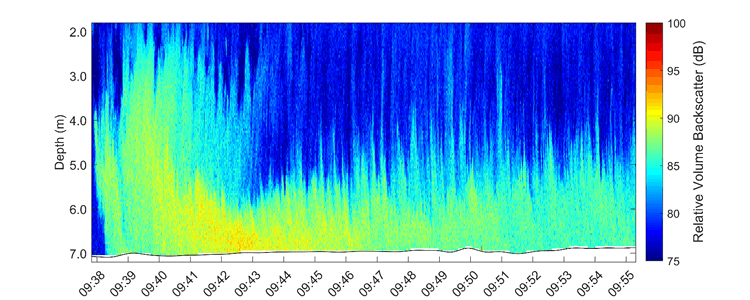M. Daugharty1*, S. Kamminga1, H. Huitema1, J. Van Heesen1, S. Nylund 1, J. Brinkkemper2
1Nortek Group BV,
2WaterProof Marine Consultancy & Services BV,
Introduction
Quantifying marine sediment and biomass in the water column informs environmental management of estuarine and coastal ocean systems. Echograms provide a non-contact means of tracking geomorphic and biological features in the water column over vast spatial and temporal domains. When coupled with current velocity data, flux rates and trajectories can be estimated. Pairing Acoustic Doppler Current Profiler (ADPC) and echo sounder technology, however, has historically yielded echograms with low resolution, limited dynamic range, and data gaps near the sea bed because of competing requirements for velocity output. Nortek's Signature1000 VM ADPC was designed to address these limitations via a fifth, single-beam echo sounder that occupies dedicated pings within the velocity data stream.
Methods
To test the success of this technology, Nortek teamed with WaterProof BV, who deployed a vessel-mounted Signature1000 in conjunction with water sampling in a tidal channel in the Fall, 2019 in the Wadden Sea, the Netherlands. The sampled region is characterized by tidal currents, dredging activities, mud flats, ferry transport, and shallow waters, making for a dynamic regime. Measurements were conducted during 13 hours to cover a full tidal cycle on four separate days in four different locations. Water samples were taken each half hour at three different water depths and analyzed for mud and sand content.
Pulse compressed and non-pulse compressed echo sounder modes were deployed with 5 cm cells and 2 Hz sample rates. Echo sounder backscatter was corrected for losses, the altimeter-derived sea bed delineation was filtered, and backscatter reflections under the bed were suppressed.
Results
Figure 1 displays an example of the high resolution echo sounder relative volume backscatter. The echogram reveals coherent patterns with variability in the vertical and horizontal domains down to the bed. Higher intensity near the sea bed suggests a greater suspended sediment concentration deeper in the water column, consistent with observed sediment samples. This has significant implications for sediment flux computations and associated dredging operations, sand nourishment activities, scour and erosion studies, and ecological restoration efforts. If used with a bottom-mounted Signature1000, which captures fine resolution to the surface, a complete picture of the water column can be obtained for the first time.

Figure 1 Non-pulse compressed echogram from a vessel-mounted Signature1000 with 5 cm pixels that extend down to the sea bed at a depth of approximately 7 m.
I. Surname1*, F.N. Another-Surname2 , Y. Next-Surname2
1 University Name, Country; 2 Organization Name, Country
* Corresponding author: mail.name@organization.org


